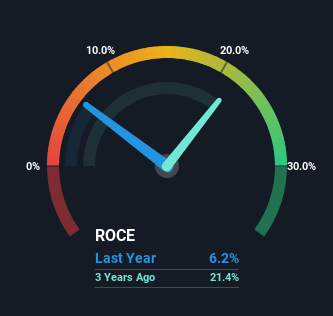- India
- /
- Energy Services
- /
- NSEI:UNIDT
Capital Allocation Trends At United Drilling Tools (NSE:UNIDT) Aren't Ideal

If we want to find a potential multi-bagger, often there are underlying trends that can provide clues. Amongst other things, we'll want to see two things; firstly, a growing return on capital employed (ROCE) and secondly, an expansion in the company's amount of capital employed. Basically this means that a company has profitable initiatives that it can continue to reinvest in, which is a trait of a compounding machine. However, after briefly looking over the numbers, we don't think United Drilling Tools (NSE:UNIDT) has the makings of a multi-bagger going forward, but let's have a look at why that may be.
What Is Return On Capital Employed (ROCE)?
If you haven't worked with ROCE before, it measures the 'return' (pre-tax profit) a company generates from capital employed in its business. Analysts use this formula to calculate it for United Drilling Tools:
Return on Capital Employed = Earnings Before Interest and Tax (EBIT) ÷ (Total Assets - Current Liabilities)
0.062 = ₹157m ÷ (₹3.3b - ₹732m) (Based on the trailing twelve months to December 2023).
So, United Drilling Tools has an ROCE of 6.2%. On its own that's a low return on capital but it's in line with the industry's average returns of 6.2%.
View our latest analysis for United Drilling Tools

While the past is not representative of the future, it can be helpful to know how a company has performed historically, which is why we have this chart above. If you want to delve into the historical earnings , check out these free graphs detailing revenue and cash flow performance of United Drilling Tools.
So How Is United Drilling Tools' ROCE Trending?
On the surface, the trend of ROCE at United Drilling Tools doesn't inspire confidence. Over the last five years, returns on capital have decreased to 6.2% from 21% five years ago. And considering revenue has dropped while employing more capital, we'd be cautious. If this were to continue, you might be looking at a company that is trying to reinvest for growth but is actually losing market share since sales haven't increased.
While on the subject, we noticed that the ratio of current liabilities to total assets has risen to 22%, which has impacted the ROCE. If current liabilities hadn't increased as much as they did, the ROCE could actually be even lower. While the ratio isn't currently too high, it's worth keeping an eye on this because if it gets particularly high, the business could then face some new elements of risk.
The Bottom Line On United Drilling Tools' ROCE
We're a bit apprehensive about United Drilling Tools because despite more capital being deployed in the business, returns on that capital and sales have both fallen. And long term shareholders have watched their investments stay flat over the last three years. That being the case, unless the underlying trends revert to a more positive trajectory, we'd consider looking elsewhere.
United Drilling Tools does come with some risks though, we found 3 warning signs in our investment analysis, and 1 of those is a bit concerning...
For those who like to invest in solid companies, check out this free list of companies with solid balance sheets and high returns on equity.
If you're looking to trade United Drilling Tools, open an account with the lowest-cost platform trusted by professionals, Interactive Brokers.
With clients in over 200 countries and territories, and access to 160 markets, IBKR lets you trade stocks, options, futures, forex, bonds and funds from a single integrated account.
Enjoy no hidden fees, no account minimums, and FX conversion rates as low as 0.03%, far better than what most brokers offer.
Sponsored ContentNew: AI Stock Screener & Alerts
Our new AI Stock Screener scans the market every day to uncover opportunities.
• Dividend Powerhouses (3%+ Yield)
• Undervalued Small Caps with Insider Buying
• High growth Tech and AI Companies
Or build your own from over 50 metrics.
Have feedback on this article? Concerned about the content? Get in touch with us directly. Alternatively, email editorial-team (at) simplywallst.com.
This article by Simply Wall St is general in nature. We provide commentary based on historical data and analyst forecasts only using an unbiased methodology and our articles are not intended to be financial advice. It does not constitute a recommendation to buy or sell any stock, and does not take account of your objectives, or your financial situation. We aim to bring you long-term focused analysis driven by fundamental data. Note that our analysis may not factor in the latest price-sensitive company announcements or qualitative material. Simply Wall St has no position in any stocks mentioned.
About NSEI:UNIDT
United Drilling Tools
Together with its subsidiary, P Mittal Manufacturing Private Limited, manufactures and sells wire line and well service equipment, gas lift gear, downhole tools, and OD casing pipes and connectors under the UDT brand in India and internationally.
Excellent balance sheet with acceptable track record.
Market Insights
Community Narratives



